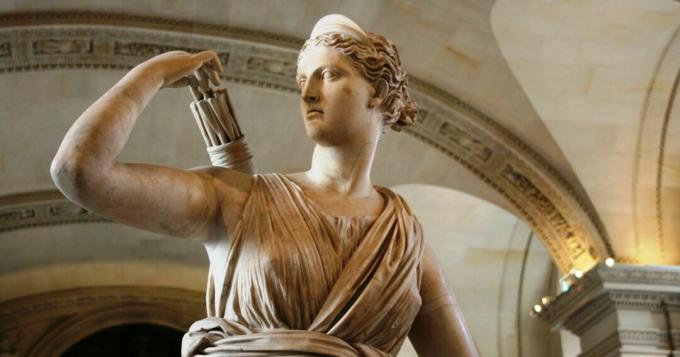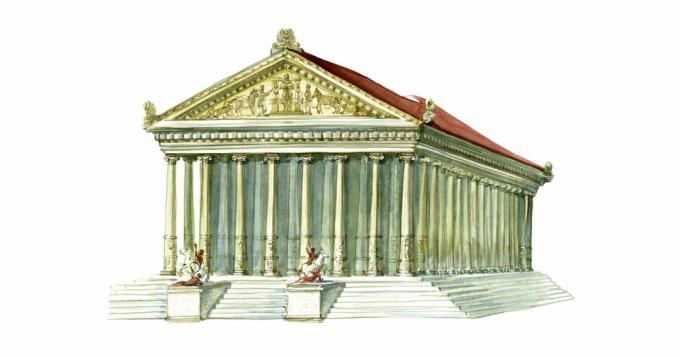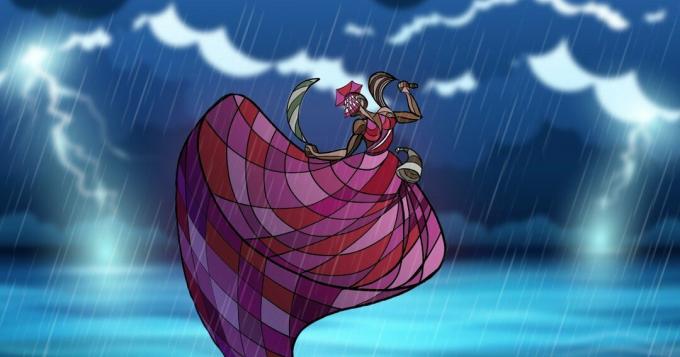Artemis, also called Artemis or Artemisia, is the Greek mythology goddess of hunting, from the wild nature, from the animal protection from the moon It's from childbirth. She is one of the most revered and powerful deities in the Greek pantheon. Also known as Diana in Roman mythology, she was the daughter of Zeus, the king of the gods, and the goddess leto.
The daughter of Zeus is often portrayed as a young huntress, with bow and arrows, and accompanied by a group of nymphs. She is described as a goddess virgin, dedicated to preserving her chastity and living in harmony with nature. Because of this, she was often portrayed as a protector of virgins and women in general.

As the goddess of the hunt, she was known for her skill and dexterity in capturing prey. She was revered by hunters, who sought her blessing and protection before setting out in search of food. In addition, she was also associated with the protection of wild animals and forests, and was often invoked to help preserve natural life.
Artemis played an important role in Greek mythology as a defender of women during childbirth. She was considered the protector of mothers and newborn children. Because of this, she was often invoked to ensure a safe pregnancy and successful delivery.
The goddess of the hunt was also revered as moon goddess, replacing the worship of selene, primordial goddess associated with the Earth's satellite.
However, she also possessed a ruthless and vengeful side. She used to punish those who disrespected her or violated the sacred nature she protected. There are several stories in Greek mythology that report her severe punishments, mainly against men who dared to cross the limits set by her.
name meaning

The origin of the name "Artemis" is uncertain, although there are several theories, which vary according to the authors and the regions where she was worshipped.
For some modern authors, the name has its origin prior to the formation of the Greek (Hellenic) civilization, and would derive from the Persian expression art ("great", "excellent", "holy").
In the Attica region, for example, her name would be linked to the expression arch ("bear"). For some ancient Greek writers, it would derive from artamos ("butcher"). For Plato, the name would come from artemis ("pure", "safe", "unharmed").
Stories of Artemis in Mythology
Greek mythology is full of fascinating stories involving the island of Zeus and other divine characters. The following are some notable episodes that highlight her interaction with other deities and heroes:
Artemis and Apollo

Artemis was Apollo's twin sister, the god of the sun. They shared a special bond and often worked together.
One of the most famous myths involving the two is the episode in which Apollo tries to seduce the naiad. Daphne. The moon goddess, protecting the naiad's chastity, turns Daphne into a laurel tree to prevent her capture by Apollo.
Orion
Orion was a skilled hunter who gained the friendship of Artemis. However, out of jealousy or distrust of other gods, Artemis is tricked into shooting an arrow at Orion, accidentally killing him. Dismayed by her friend's death, Artemis places Orion in the heavens as the constellation of Orion.
Actaeon
Actaeon, a mortal hunter, witnesses the huntress goddess bathing in a stream. As punishment for invading her privacy, Artemis turns Actaeon into a stag. Actaeon's own hounds chase and devour him, not recognizing him as their master.
Theseus
Theseus, the legendary Athenian hero, meets Artemis when he goes to Mount Olympus to seek divine help. She grants him a silver thread to help him get out of the Labyrinth of Crete after his fight with the Minotaur.
Callisto
Callisto was a beautiful nymph who was part of Artemis' entourage. However, Zeus fell in love with Callisto and seduced her, resulting in a pregnancy. When the goddess discovered the betrayal, she turned Callisto into a bear. Later, Callisto is reunited with her son, Arcas, who almost kills her while hunting. To avoid tragedy, Zeus turns both into constellations - Ursa Major and Ursa Minor.
Bibliography:
- BULFLINCH, Thomas. The Golden Book of Mythology. Rio de Janeiro: Ediouro, 2006.
JAEGER, Werner. Paideia: the formation of the Greek man. São Paulo: Martins Fontes, 2013.
See too:
- Mythology
- Greek mythology
- Greek gods
- Norse mythology
- indian gods



